#keystone species post
Text
The Kenya Wildlife Service celebrated the successful transfer of 21 eastern black rhinos to establish a new viable breeding population for the species that was on the brink of extinction decades ago.
In an 18-day exercise executed by highly trained capture and veterinary experts, the Loisaba Conservancy received the 21 rhinos from three different locations, becoming the 17th sanctuary in Kenya where the mammoth animals can roam and intermingle.
“It’s incredibly exciting to be part of the resettlement of rhinos to a landscape where they’ve been absent for 50 years,” said Tom Silvester, CEO of Loisaba Conservancy.
Kenya had 20,000 black rhinos in the 1970s before poachers decimated them for their horns. By the time the Kenya Wildlife Service (KWS) was established in 1989, rhino numbers had declined to below 400.
Since then, Kenya’s eastern black rhinos have made a remarkable comeback and today there are an estimated 1,004 individuals.
Kenya is a stronghold of the eastern sub species of black rhino, hosting approximately 80 percent of the entire world’s surviving population.
“Surpassing the milestone of 1,000 rhinos within four decades is a significant accomplishment,” said Munira Bashir, Director of The Nature Conservancy in Kenya.
The reintroduction this month of these 21 animals this month is a great milestone in Kenya’s rhino recovery action plan, and was made possible by support from The Nature Conservancy, San Diego Zoo Wildlife Alliance, other partners—and the three reserves from where the 21 rhinos originated, Nairobi National Park, Ol Pejeta Conservancy and Lewa Conservancy.
“In the recent past, one of the main causes of mortality of rhinos has been territorial fights due to limited space in sanctuaries which has also led to suppressed growth rates due,” explained Dr. Erustus Kanga, the Director General of Kenya Wildlife Service. “I am elated to be associated with this momentous effort to secure more space for this cornerstone species.”
Meanwhile, southern white rhinos continue to thrive in Kenya, having increased from 50 individuals that were imported from South Africa in the eighties and nineties to reach the current population of 971 individuals.
Kenya is also playing a critical role in efforts to save the northern white rhino from extinction, as it is host to the only remaining two females of the species left in the world. The international BioRescue project has developed thirty embryos awaiting implantation into surrogate females within the closely-related subspecies of southern white rhino.
“The return of black rhinos to Loisaba, 50 years after the last known individual here was killed by poachers in the 1970s, is a demonstration of how impactful partnerships between governments and conservation NGOs can be for restoring, managing, and protecting our natural world,” said Dr. Max Graham, CEO and Founder of Space for Giants, one of the project partners.
“And, of course, the return of black rhinos here gives all of us one of the most precious commodities of all: hope.”
-via Good News Network, February 25, 2024
#rhino#rhinoceros#conservation#hope posting#endangered species#wildlife#kenya#good news#hope#zoology#zoo animals#keystone species
341 notes
·
View notes
Text
underrated genre of post is when the convex bloggers post one of the most insanely specific images you've ever seen in a meme template you've never seen before in your life, with a clip attached to it. And you go into it like surely not; surely this random video clip of a conversation can't be that specific and capture all of these extremely disparate elements. And you watch the clip - it's from like season 6 or whatever when convex was big - and it illustrates the theme or emotion displayed in the accompanying image perfectly. It's never a normal human emotion and it's always convex and it gets me every time
#anyway i think the convex girlies (gender neutral) are a keystone species in hermitblr and we should all love them more#hermitcraft#convex#hermitblr#i don't know if this makes sense but surely it isnt just me right. those posts kill me#astro speaks
86 notes
·
View notes
Text
I feel likes it’s necessary for every piece of media to have at least one character it is physically impossible to be normal about
#like a keystone species in an ecosystem#things just don’t work right with out them#was thinking about the eighth doctor when I made this post#eighth doctor#doctor who#feel like this also applies to Frank iero fans#I see what you guys say about him#frank ireo#mcr#house md#I don’t thinks it’s possible to be normal about that show in general#fandom#now I’m just going to add tags so people see this#tma#the mechanisms#supernatural#rqg#the magicians#wwdits
283 notes
·
View notes
Text
🐘 * presses my foot in the watery mud so that smaller mutuals can drink from the newly created puddle *
12 notes
·
View notes
Text
There, in the sunlit forest on a high ridgeline, was a tree I had never seen before.
I spend a lot of time looking at trees. I know my beech, sourwood, tulip poplar, sassafras and shagbark hickory. Appalachian forests have such a diverse tree community that for those who grew up in or around the ancient mountains, forests in other places feel curiously simple and flat.
Oaks: red, white, black, bur, scarlet, post, overcup, pin, chestnut, willow, chinkapin, and likely a few others I forgot. Shellbark, shagbark and pignut hickories. Sweetgum, serviceberry, hackberry, sycamore, holly, black walnut, white walnut, persimmon, Eastern redcedar, sugar maple, red maple, silver maple, striped maple, boxelder maple, black locust, stewartia, silverbell, Kentucky yellowwood, blackgum, black cherry, cucumber magnolia, umbrella magnolia, big-leaf magnolia, white pine, scrub pine, Eastern hemlock, redbud, flowering dogwood, yellow buckeye, white ash, witch hazel, pawpaw, linden, hornbeam, and I could continue, but y'all would never get free!
And yet, this tree is different.
We gather around the tree as though surrounding the feet of a prophet. Among the couple dozen of us, only a few are much younger than forty. Even one of the younger men, who smiles approvingly and compliments my sharp eye when I identify herbs along the trail, has gray streaking his beard. One older gentleman scales the steep ridge slowly, relying on a cane for support.
The older folks talk to us young folks with enthusiasm. They brighten when we can call plants and trees by name and list their virtues and importance. "You're right! That's Smilax." "Good eye!" "Do you know what this is?—Yes, Eupatorium, that's a pollinator's paradise." "Are you planning to study botany?"
The tree we have come to see is not like the tall and pillar-like oaks that surround us. It is still young, barely the diameter of a fence post. Its bark is gray and forms broad stripes like rivulets of water down smooth rock. Its smooth leaves are long, with thin pointed teeth along their edges. Some of the group carefully examine the bark down to the ground, but the tree is healthy and flourishing, for now.
This tree is among the last of its kind.
The wood of the American Chestnut was once used to craft both cradles and coffins, and thus it was known as the "cradle-to-grave tree." The tree that would hold you in entering this world and in leaving it would also sustain your body throughout your life: each tree produced a hundred pounds of edible nuts every winter, feeding humans and all the other creatures of the mountains. In the Appalachian Mountains, massive chestnut trees formed a third of the overstory of the forest, sometimes growing larger than six feet in diameter.
They are a keystone species, and this is my first time seeing one alive in the wild.
It's a sad story. But I have to tell you so you will understand.
At the turn of the 20th century, the chestnut trees of Appalachia were fundamental to life in this ecosystem, but something sinister had taken hold, accidentally imported from Asia. Cryphonectria parasitica is a pathogenic fungus that infects chestnut trees. It co-evolved with the Chinese chestnut, and therefore the Chinese chestnut is not bothered much by the fungus.
The American chestnut, unlike its Chinese sister, had no resistance whatsoever.
They showed us slides with photos of trees infected with the chestnut blight earlier. It looks like sickly orange insulation foam oozing through the bark of the trees. It looks like that orange powder that comes in boxes of Kraft mac and cheese. It looks wrong. It means death.
The chestnut plague was one of the worst ecological disasters ever to occur in this place—which is saying something. And almost no one is alive who remembers it. By the end of the 1940's, by the time my grandparents were born, approximately three to four billion American chestnut trees were dead.
The Queen of the Forest was functionally extinct. With her, at least seven moth species dependent on her as a host plant were lost forever, and no one knows how much else. She is a keystone species, and when the keystone that holds a structure in place is removed, everything falls.
Appalachia is still falling.
Now, in some places, mostly-dead trees tried to put up new sprouts. It was only a matter of time for those lingering sprouts of life.
But life, however weak, means hope.
I learned that once in a rare while, one of the surviving sprouts got lucky enough to successfully flower and produce a chestnut. And from that seed, a new tree could be grown. People searched for the still-living sprouts and gathered what few chestnuts could be produced, and began growing and breeding the trees.
Some people tried hybridizing American and Chinese chestnuts and then crossing the hybrids to produce purer American strains that might have some resistance to the disease. They did this for decades.
And yet, it wasn't enough. The hybrid trees were stronger, but not strong enough.
Extinction is inevitable. It's natural. There have been at least five mass extinctions in Earth's history, and the sixth is coming fast. Many people accepted that the American chestnut was gone forever. There had been an intensive breeding program, summoning all the natural forces of evolution to produce a tree that could survive the plague, and it wasn't enough.
This has happened to more species than can possibly be counted or mourned. And every species is forced to accept this reality.
Except one.
We are a difficult motherfucker of a species, aren't we? If every letter of the genome's book of life spelled doom for the Queen of the Forest, then we would write a new ending ourselves. Research teams worked to extract a gene from wheat and implant it in the American chestnut, in hopes of creating an American chestnut tree that could survive.
This project led to the Darling 58, the world's first genetically modified organism to be created for the purpose of release into the wild.
The Darling 58 chestnut is not immune, the presenters warned us. It does become infected with the blight. And some trees die. But some live.
And life means hope.
In isolated areas, some surviving American Chestnut trees have been discovered, most of them still very young. The researchers hope it is possible that some of these trees may have been spared not because of pure luck, but because they carry something in their genes that slows the blight in doing its deadly work, and that possibly this small bit of innate resistance can be shaped and combined with other efforts to create a tree that can live to grow old.
This long, desperate, multi-decade quest is what has brought us here. The tree before me is one such tree: a rare survivor. In this clearing, a number of other baby chestnut trees have been planted by human hands. They are hybrids of the Darling 58 and the best of the best Chinese/American hybrids. The little trees are as prepared for the blight as we can possibly make them at this time. It is still very possible that I will watch them die. Almost certainly, I will watch this tree die, the one that shades us with her young, stately limbs.
Some of the people standing around me are in their 70's or 80's, and yet, they have no memory of a world where the Queen of the Forest was at her full majesty. The oldest remember the haunting shapes of the colossal dead trees looming as if in silent judgment.
I am shaken by this realization. They will not live to see the baby trees grow old. The people who began the effort to save the American chestnut devoted decades of their lives to these little trees, knowing all the while they likely never would see them grow tall. Knowing they would not see the work finished. Knowing they wouldn't be able to be there to finish it. Knowing they wouldn't be certain if it could be finished.
When the work began, the technology to complete it did not exist. In the first decades after the great old trees were dead, genetic engineering was a fantasy.
But those that came before me had to imagine that there was some hope of a future. Hope set the foundation. Now that little spark of hope is a fragile flame, and the torch is being passed to the next generation.
When a keystone is removed, everything suffers. What happens when a keystone is put back into place? The caretakers of the American chestnut hope that when the Queen is restored, all of Appalachia will become more resilient and able to adapt to climate change.
Not only that, but this experiment in changing the course of evolution is teaching us lessons and skills that may be able to help us save other species.
It's just one tree—but it's never just one tree. It's a bear successfully raising cubs, chestnut bread being served at a Cherokee festival, carbon being removed from the atmosphere and returned to the Earth, a wealth of nectar being produced for pollinators, scientific insights into how to save a species from a deadly pathogen, a baby cradle being shaped in the skilled hands of an Appalachian crafter. It's everything.
Despair is individual; hope is an ecosystem. Despair is a wall that shuts out everything; hope is seeing through a crack in that wall and catching a glimpse of a single tree, and devoting your life to chiseling through the wall towards that tree, even if you know you will never reach it yourself.
An old man points to a shaft of light through the darkness we are both in, toward a crack in the wall. "Do you see it too?" he says. I look, and on the other side I see a young forest full of sunlight, with limber, pole-size chestnut trees growing toward the canopy among the old oaks and hickories. The chestnut trees are in bloom with fuzzy spikes of creamy white, and bumblebees heavy with pollen move among them. I tell the man what I see, and he smiles.
"When I was your age, that crack was so narrow, all I could see was a single little sapling on the forest floor," he says. "I've been chipping away at it all my life. Maybe your generation will be the one to finally reach the other side."
Hope is a great work that takes a lifetime. It is the hardest thing we are asked to do, and the most essential.
I am trying to show you a glimpse of the other side. Do you see it too?
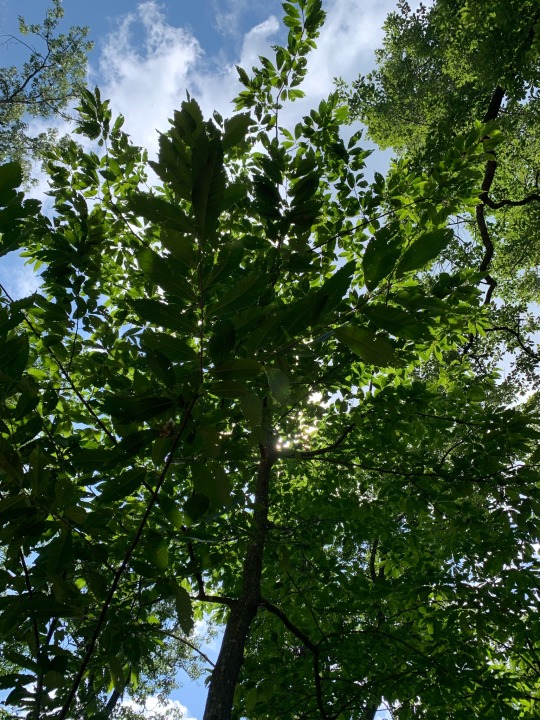
#american chestnut#hope#climate change#biodiversity crisis#climate crisis#trees#plantarchy#learning to imagine the future
3K notes
·
View notes
Text
Existence Value: Why All of Nature is Important Whether We Can Use it or Not
I spend a lot of time around other nature nerds. We’re a bunch of people from varying backgrounds, places, and generations who all find a deep well of inspiration within the natural world. We’re the sort of people who will happily spend all day outside enjoying seeing wildlife and their habitats without any sort of secondary goal like fishing, foraging, etc. (though some of us engage in those activities, too.) We don’t just fall in love with the places we’ve been, either, but wild locales that we’ve only ever seen in pictures, or heard of from others. We are curators of existence value.
Existence value is exactly what it sounds like–something is considered important and worthwhile simply because it is. It’s at odds with how a lot of folks here in the United States view our “natural resources.” It’s also telling that that is the term most often used to refer collectively to anything that is not a human being, something we have created, or a species we have domesticated, and I have run into many people in my lifetime for whom the only value nature has is what money can be extracted from it. Timber, minerals, water, meat (wild and domestic), mushrooms, and more–for some, these are the sole reasons nature exists, especially if they can be sold for profit. When questioning how deeply imbalanced and harmful our extractive processes have become, I’ve often been told “Well, that’s just the way it is,” as if we shall be forever frozen in the mid-20th century with no opportunity to reimagine industry, technology, or uses thereof.
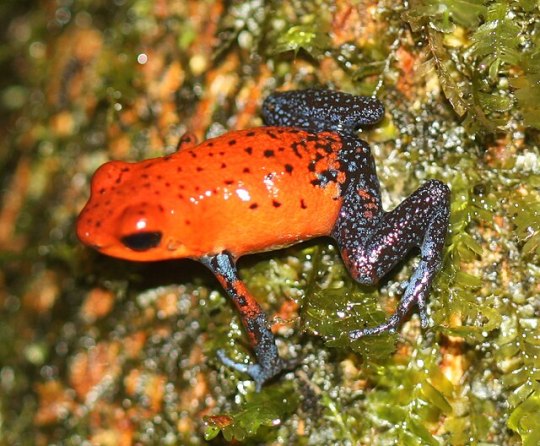
Moreover, we often assign positive or negative value to a being or place based on whether it directly benefits us or not. Look at how many people want to see deer and elk numbers skyrocket so that they have more to hunt, while advocating for going back to the days when people shot every gray wolf they came across. Barry Holstun Lopez’ classic Of Wolves and Men is just one of several in-depth looks at how deeply ingrained that hatred of the “big bad wolf” is in western mindsets, simply because wolves inconveniently prey on livestock and compete with us for dwindling areas of wild land and the wild game that sustained both species’ ancestors for many millennia. “Good” species are those that give us things; “bad” species are those that refuse to be so complacent.
Even the modern conservation movement often has to appeal to people’s selfishness in order to get us to care about nature. Look at how often we have to argue that a species of rare plant is worth saving because it might have a compound in it we could use for medicine. Think about how we’ve had to explain that we need biodiverse ecosystems, healthy soil, and clean water and air because of the ecosystem services they provide us. We measure the value of trees in dollars based on how they can mitigate air pollution and anthropogenic climate change. It’s frankly depressing how many people won’t understand a problem until we put things in terms of their own self-interest and make it personal. (I see that less as an individual failing, and more our society’s failure to teach empathy and emotional skills in general, but that’s a post for another time.)
Existence value flies in the face of all of those presumptions. It says that a wild animal, or a fungus, or a landscape, is worth preserving simply because it is there, and that is good enough. It argues that the white-tailed deer and the gray wolf are equally valuable regardless of what we think of them or get from them, in part because both are keystone species that have massive positive impacts on the ecosystems they are a part of, and their loss is ecologically devastating.
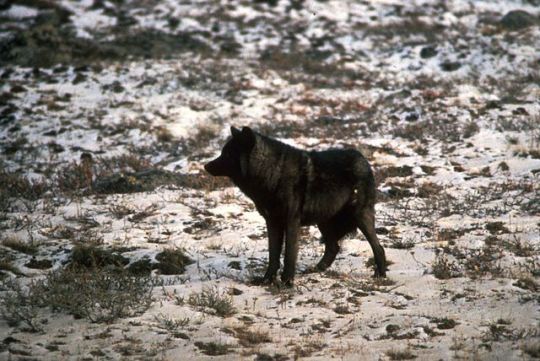
But even those species whose ecological impact isn’t quite so wide-ranging are still considered to have existence value. And we don’t have to have personally interacted with a place or its natural inhabitants in order to understand their existence value, either. I may never get to visit the Maasai Mara in Kenya, but I wish to see it as protected and cared for as places I visit regularly, like Willapa National Wildlife Refuge. And there are countless other places, whose names I may never know and which may be no larger than a fraction of an acre, that are important in their own right.
I would like more people (in western societies in particular) to be considering this concept of existence value. What happens when we detangle non-human nature from the automatic value judgements we place on it according to our own biases? When we question why we hold certain values, where those values came from, and the motivations of those who handed them to us in the first place, it makes it easier to see the complicated messes beneath the simple, shiny veneer of “Well, that’s just the way it is.”
And then we get to that most dangerous of realizations: it doesn’t have to be this way. It can be different, and better, taking the best of what we’ve accomplished over the years and creating better solutions for the worst of what we’ve done. In the words of Rebecca Buck–aka Tank Girl–“We can be wonderful. We can be magnificent. We can turn this shit around.”
Let’s be clear: rethinking is just the first step. We can’t just uproot ourselves from our current, deeply entrenched technological, social, and environmental situation and instantly create a new way of doing things. Societal change takes time; it takes generations. This is how we got into that situation, and it’s how we’re going to climb out of it and hopefully into something better. Sometimes the best we can do is celebrate small, incremental victories–but that’s better than nothing at all.
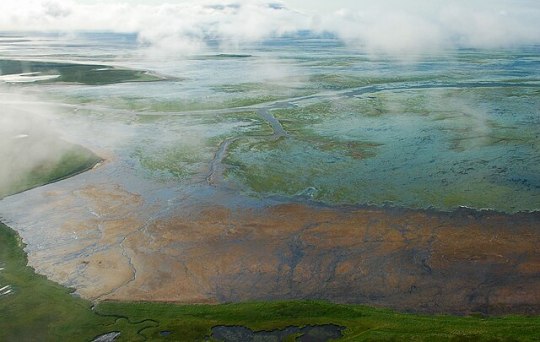
Nor can we just ignore the immensely disproportionate impact that has been made on indigenous and other disadvantaged communities by our society (even in some cases where we’ve actually been trying to fix the problems we’ve created.) It does no good to accept nature’s inherent value on its own terms if we do not also extend that acceptance throughout our own society, and to our entire species as a whole.
But I think ruminating on this concept of existence value is a good first step toward breaking ourselves out first and foremost. And then we go from there.
Did you enjoy this post? Consider taking one of my online foraging and natural history classes or hiring me for a guided nature tour, checking out my other articles, or picking up a paperback or ebook I’ve written! You can even buy me a coffee here!
#nature#natural history#ecology#wildlife#animals#environment#environmentalism#conservation#existence value#deep ecology#science#scicomm#environmental philosophy#climate change
556 notes
·
View notes
Note
Does your post about wasps and beetles and moths also include guinea worms? Or are we still ok to eradicate those? They evolved specifically to only reproduce by causing painful lesions on human feet, though we've put enough selection pressure on them that they now infect dogs and cats as well.
They are not a major food source for any organism that we know of. They are not a keystone species of any ecosystem. Do they have intrinsic value, so that we should let them live to keep infecting people without access to clean water? They aren't doing anything for the ecosystem.
This is the kind of topic biologists with PhDs spend years writing research papers about, and I don't see you offering any grant money.
Also, I'm not sure if the blog was enough of a clue, but I specialize in Accipitriformes. I'm a really weird person to ask this to. You'd probably be better served asking @bogleech or someone similar.
Final aside... the original post specified pollinators so uh. No? I guess? It would not include this apparently non-pollinator species. No comment on whether I would personally choose to wipe it out because I don't have a god complex, but the post was about an entirely different taxonomic field.
#ask#hawk talks#bogleech#sorry to involve you mr leech but you know a lot about parasites#and i do not
448 notes
·
View notes
Text
Wet Beast Wednesday: aquatic insect larvae
This Wet Beast Wednesday is going to be different than usual. Instead of an in-depth overview of a specific species or group of species, I'm going to give a general overview of aquatic insect larvae as a whole and then showcase some groups of insects. I'm going to focus on insects that have an aquatic larval stage and terrestrial adult stage, saving adult aquatic insects for another post.
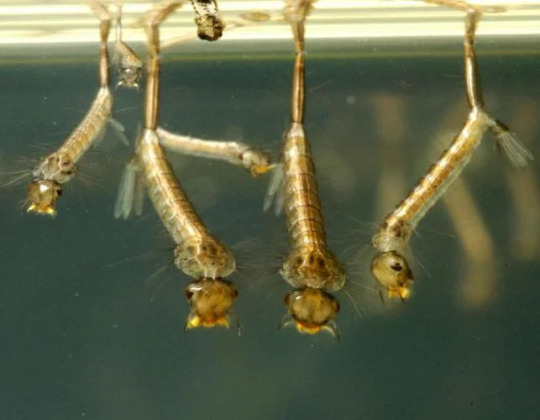
(Image ID: a group of mosquito larvae. They are yellowish bugs with long, slender bodies, no visible limbs, small heads, and feathery appendages from their rear ends. From the back of the abdomen, a snorkel-like appeadage attaches to the surface of the water, using surface tension to allow the larvae to hang from the surface. End ID)
Insects are basically the most successful group of animals in the history of life on Earth and have adapted to live in just about every terrestrial habitat. It should not be much of a surprise than that they have also moved into the water. More specifically, fresh water as almost all aquatic insects inhabit fresh or maybe brackish water. Only the water strider genus Halobates are truly marine. Some species of insect are aquatic for their entire lives, some are primarily terrestrial but able to swim, and some are aquatic only for their larval stage of life. These aquatic larvae species are generally agreed to have evolved from fully terrestrial ancestors. The adaptation of partially returning to the water has evolved independently many times in many different clades of insect and so different species use different strategies and adaptations. It is possible that aquatic larvae evolved in response to high competition for resources on land. If multiple species are competing over the same resources during their larval stages but one of those species manages to adapt to a whole new environment, that species will now have abundant access to resources the other species are unable to get to. Because of the very different lifestyles required for aquatic and terrestrial animals, aquatic larvae often look very different than their adult forms.
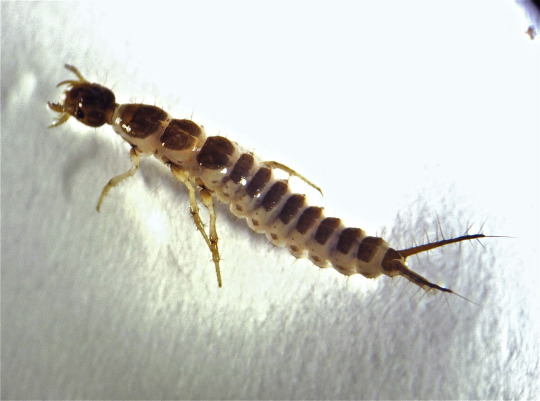
(Image: an aquatic beetle larva. It looks nothing like an adult beetle, instead being a long, slender insect with no wings, multiple body segments, and two hairy appendages at the base of the abdomen. End ID)
Aquatic larvae serve important roles in their ecosystems. Many are herbivores or detritivores that consume algae and bits of biological material, helping recycle nutrients and clean the water. Some are predators that hunt smaller invertebrates or plankton. Importantly, aquatic insect larvae provide a major food source for larger fish, invertebrates, birds, and so on. Some species can be considered keystone species, vital to their ecosystems. Many species are highly sensitive to changes in their environment, allowing them to act as indicator species for the health of their ecosystems. The trio of mayflies, stoneflies, and caddisflies are very commonly used as indicators of pollution as all three are highly sensitive to pollutants. A stream with few mayflies, stoneflies, or caddisflies but plenty of less sensitive species is likely to be polluted.
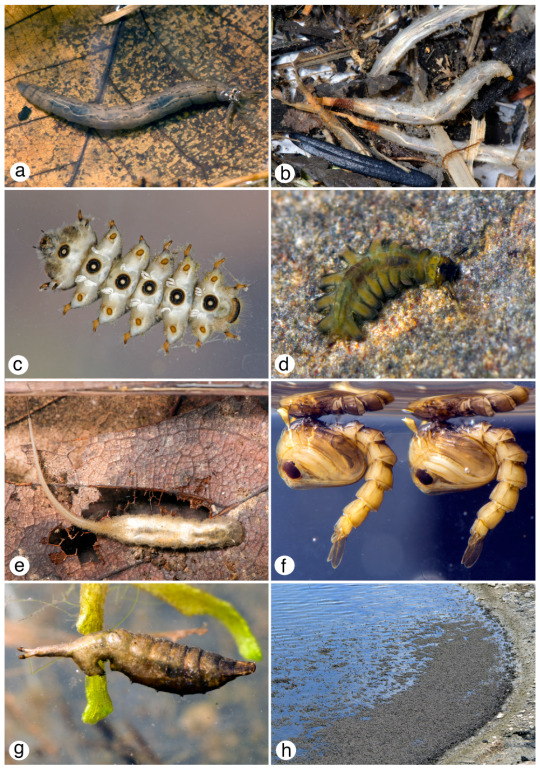
(Image ID: a collage of aquatic larvae of multiple species in the order Diptera (true flies. They vary from slug-like to having multiple distinct body segments with legs, to looking like maggots with long tails. End ID. Source)
Mayflies (order Ephemeroptera) are among the oldest lineages of winged insects, bearing traits that they first flying insect also had. Juvenile mayflies are technically not larvae, but nymphs. The difference between a larva and a nymph is that nymphs look much more like the adult stage than larvae do. Mayfly nymphs lack the wings of adults, but have external gills growing from the sides of their abdomens. Mayfly nymphs can be identified by three appendages called cerci that emerge from the back of the abdomen. They are bottom-dwellers that typically live under rocks and other objects or amid plants. Most are herbivores, feeding mainly on algae. Months to years after hatching (species dependent), mayflies will float to the surface and go through a molt to a stage called the subimago. Uniquely among insects, mayflies go through two final winged molts. The first is to a not sexually mature stage called the subimago, then they quickly molt again into a fully mature imago stage. These molts happen in sync, resulting in hundreds to thousands of mayflies appearing all at once and swarming together to mate. Famously, adult mayflies exist only to mate and die. Their digestive systems are non-functional and few species last past a few days.

(Image: a mayfly nymph on a rock. It is a yellow bug with no wings, a long abdomen, and thick, grasping legs. Three long, hairy cerci emerge from the back. Along the side of the abdomen are multiple pairs of white, feathery gills. End ID)
Stoneflies (order Plecoptera) also have nymphs and can be quite difficult to tell apart from mayfly nymphs if you don't know what to look for. One of the biggest differences is that their gills are located by the base of the legs rather than along the abdomen. Like mayflies, stoneflies are some of the most primitive winged insects, but mayflies are Paleopterans (the earliest wings insects) while stoneflies and most other winged insects are Neopterans. The main difference is that Neopterans can flex their wings over their abdomens while Paleopterans cannot, and must hold their wings either out to the side or up in the air. Like with Mayflies, many adult stoneflies have nonfunctional digestive systems and exist only to mate and die.

(Image: a stonefly larva. It looks similar to a mayfly larva, but has a shorter abdomen, gills along the base of the legs, and only two cerci. End ID)
Caddisflies (order tricoptera) are the builders of the aquatic insect world. These larvae (most species anyway) can produce silk from glands near their mouths. These are used to make a variety of structures made from silk and various other materials including sand, silt, plant parts, shells, rock, and so on. Different species will seek out specific materials for their structures. There are a few types of structures, the most common of which is a tubular case that is open at both ends. The larva can carry the case with it as it crawls around and can retreat into the case for protection. The larva can draw water into one end of the case and out the other, allowing oxygenated water to flow over the gills. By moving around in the case, the larva can draw in more water. This allows the larvae to survive in water that is too oxygen-poor for other larvae. Other species build different structures including turtle-shell like domes or stationary retreats. My favorite structures are nets built with an open end into current. The current naturally brings detritus and micro-invertebrates into the net, where the larva can eat them. Caddisflies also pupate into pupa that have mandibles to cut their way out of their cases and swimming legs. Once developed, the pupae swim to the surface and molt into their adult forms. This molting is synchronized to ensure the adults emerge in swarms and can easily find mates.
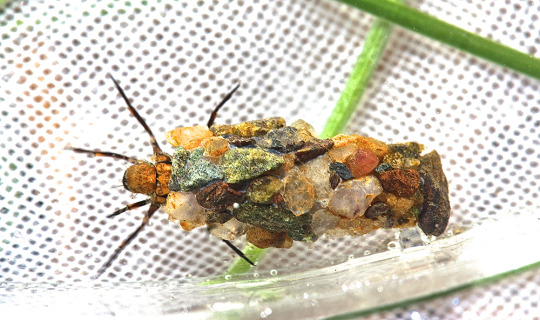
(Image ID: a caddisfly larva in its case. The case is a tube composed of pebbles of different colors stuck together with silk. The head and legs of the larva are merging from the front of the case. End ID)
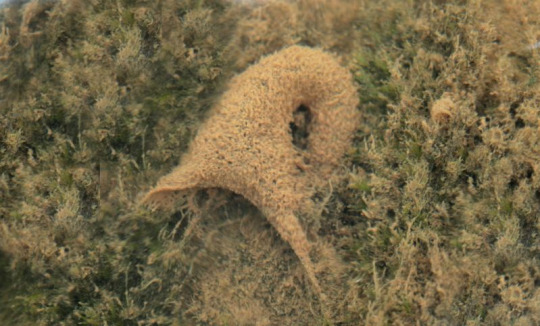
(Image: a caddisfly net. It is a structure made of silk shaped like a tube that is wide at one end and tapers toward the other. It is curved so both ends face the same way. End ID)
The order Megaloptera consists of alderflies, dobsonflies, and fishflies. All three have aquatic larvae, but their eggs are laid on land. Most species lad their eggs on plants overhanging the water so the larvae fall in once hatched, though a few lay eggs near the water's edge, forcing the larvae to crawl in. Meglaoptera have the least amount of differences between larva and adult of all holometabolous (pupa-forming) insects. The largest differences between the larvae and adults is the larvae lack wings and some species have leg-like prolegs. All species are carnivorous as larvae and feed on other invertebrates.
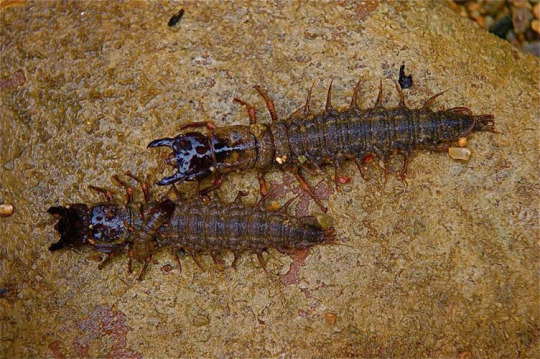
The adults don't look any less creepy
(Image: two hellgrammites, the larval form of a dobsonfly. It looks somewhat like a centipede with three pairs of limbs and a long abdomen with multiple pairs of leg-like prolegs. The head has no visible antennae, but does have a pair of powerful pincers. End ID)
Order Odonata consists of dragonflies and damselflies. These are powerful predators both as nymphs and adults. As nymphs, the juveniles are shorter and stockier than the adults, with no wings. The nymphs (or naiads) breathe through gills. In damselflies, these gills can be external, but dragonfly nymphs have their gills located in the anus. Damselflies can swim by undulating their gills, but dragonfly nymphs are restricted to crawling. The nymphs are voracious predators that will feed on anything they can catch. Most of their diet consists of invertebrates, but they will also attack small fish, tadpoles, and even salamanders.
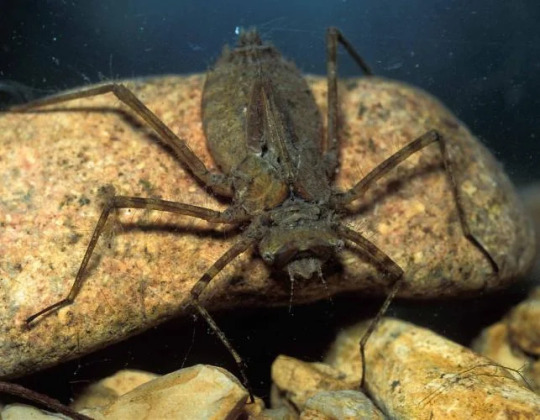
(Image ID: a dragonfly larva on a rock. Its head is similar to that of the adults, but the abdomen is much shorter and broader and the legs are longer. It has no wings and is brown all over. End ID)
The groups of insects I covered today (plus the stoneflies) all have exclusively or near-exclusively have aquatic larvae while the adults are terrestrial. In other groups, aquatic larvae may be present in some species while others have terrestrial larvae. For example, a great many members of the order Diptera (true flies) have aquatic larvae including all mosquitos, while other members of the order have fully terrestrial larvae. In addition there are species of beetle (order Coleoptera), moth (order Lepidoptera), lacewing (order Neuroptera), and scorpionflies (order Mecoptera) that have aquatic larvae and some species of the true bugs (order Hemiptera) have aquatic larvae and aquatic adults, including water skaters, water scorpions, and giant water bugs. Aquatic insects are so prevalent that it is rare to find any lasting body of water that doesn't host some aquatic larvae or adults. Even incredibly stagnant and filthy water can host aquatic insect larvae, as shown by the notorious rat-tailed maggots, who love stagnant water and breathe through snorkels. Many species require very specific conditions and there are species of insect who exclusively grow their larvae in specific streams or lakes. Because of this, conservation of these bodies of water is vital to their survival and pollution, damming, and other factors can destroy whole species.
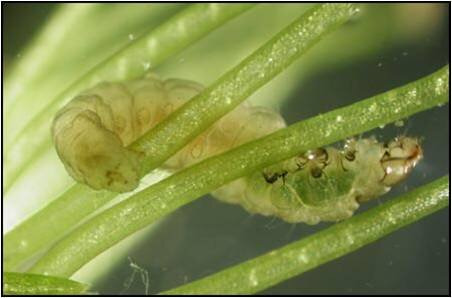
(Image: an aquatic moth larva. It looks very similar to a green land caterpillar, with none of the fancy elements many land species have. It is translucent and wrapped around some aquatic plant stems. End ID)
#wet beast wednesday#insects#insect larvae#aquatic insect larvae#larva#pupa#mayfly#stonefly#caddisfly#dobsonfly#hellgrammite#dragonfly#damselfly#freshwater ecology#ecology#biology#zoology#invertebrate#invertebrates#animal facts#informative#bug#bugs
35 notes
·
View notes
Note
i remember seeing one(maybe two(?)) of your posts about gods and how humans used to have their own gods (iirc there was also something about how humans interact with nature but i forgot)
but i saved it to read later because i needed to sleep but now i cant find it and I'm starting to think it was a dream ksksjsjsj
I remember that post! I still think about it. Thinking about leeches made me get really emotional about ecology lmao.
Leeches rely on human livestock. Many trees live longer when coppiced and pollarded. Moorland is a biome that thrives through management, if the gorse is left too long, it simply scorches the land to ash.
I just... god it's so beautiful. How humans are part of nature. The connection between culture, religion, and land. We're not separate from it, humans are a keystone species and this part of the british ecosystem evolved to accommodate early hominids.
Since that post I've learned a lot more, to become more furious at the exploitation, extinctions, and botched management of the ecology of this region.. But that's exactly it. Botched.
There's nothing inherently evil about humans and the only reason why it can't go back is because that's being PREVENTED by selfish interest. The problem is unsustainable agriculture and bad building practices, by way of greed or by ignorance.
Ignorance we can fix. Greed we can beat. It'll never be the same and that's okay!! It's not too late to MAKE IT BETTER!
Initially I'd approached the spirituality of the project as making the gods "beyond" the mortals in the setting, like older things of some pristine, bygone era. I now believe that's actually a bad mindset. What are gods? What is religion? An extension of ourselves. The collective dream of human belief.
You're part of nature. Spirituality is a part of you. Nature is part of spirituality. All of these things have an affect on each other... or, they should.
And, y'know, I know it's Battle Cat Fanfiction, it's inherently a bit silly. But, funny as it may be, it's my art and my passion.
So anyway with humans and the clan cats, I really write clan cats like small hominids with a carnivorous diet. It's looking at canon and going, "Yes And," because they absolutely don't write with realistic biology in mind haha. I hope that I'm teaching people some cool things about this environment. And I hope that I can get people to think about the changing nature of culture.
In this setting, I think that humans used to have many gods of their own, and there still exist many beyond the scope of the setting. But in this region, human spirituality is being severely neglected. Various cultures of cats are keeping these sorts of beliefs alive, right under humanity's noses.
Big ramble but... *Shrugs.* Just stuff I think about sometimes.
69 notes
·
View notes
Note
Hi there, Frieza!!
I'm a researcher writing a book about the ins and outs of Icejin Culture. Seeing as you're one of the few left, I need your assistance.
What are some rarely known facts about your species? Customs? Taboos? Preferences?
Give as much information as you're comfortable with.
Thank you,
RR Interstellar Research Facilities
$73 Cicada Drive
XX217
Nosy, nosy. Hoho...
Fine, I'll bite. Do keep in mind that some of this was learned secondhand-- despite holding the throne I prefer to focus on the business side of things and don't spend much time on my planet of origin. Further still, I prefer not to associate myself with the species at large, bearing my mutations and abject superiority in mind. As the prince of that sad lot, though, I'm obviously the most relevant person to ask. Forgive me if I ramble; I'll put it under a cut in post.
Now, let's see. 'Customs' could range anywhere from religion to breakfast preferences. I'll cover some of the ground in between, but I'm not going to type an essay for you. If you want more than what I give, send another message, and be more specific.
To begin with, the species has many names, as I've mentioned before. Here are some of the ones I've encountered in my travels:
Icejin (Most common.)
Arcosian (Scientifically accurate.)
Frost Demon (Fond of this one.)
Glaesar (Less common. Very formal usage.)
Polarite (Rarely used. Probably archaic.)
Suliform (I believe this is derived from 'Arcosulite', the unique mineral found in biogem shells.)
Changeling (Obvious origin.)
Culturally, the most prominent keystones are these--eloquence, formality, education, competition, and achievement. It's considered very rude to speak casually to someone with whom you are not close; you may think an individual is gibbering mad when he addresses you in riddles and tongues, but that's only because the general population is staggeringly naive. You must learn to read a room, and to never trust someone at first glance.
Or at first reading. Heh. I hope you've not been taking everything I say here at face value.
Children learn early on the importance of social hierarchy. Climbing it came naturally to me, but I've seen how the proletariat scrabble over each other with such thinly-veiled desperation. Resources are scarce on the home planet, after all; that is, I believe, why we became such competent spacefarers in the first place.
Arcos is an inhospitable world. The few times I've visited it's been out of obligation to appeal to those remaining (mostly the elderly, infirm, or very young; nobody stays there long). I can't have them forgetting about their Prince, after all.
Ah, here's a fun fact--the point on Kuriza's head is a vestigial egg tooth. I only learned this after he was born; I'd no idea what the thing was for until I asked around. It's cute, isn't it? Evidently ovoviviparity only became the norm a couple of generations prior, and before that the egg would remain intact until a few hours afterward...
Hm. Let me think of more. I'll only bother with the interesting ones.
-Makeup denotes status. A nobleperson appearing without a full face of makeup in public is grounds for a legitimate scandal.
-It's possible to approximate a person's power level by their biogem color. The closer to violet, the stronger they are. Something, something, life energy -> radiation -> light frequency, something, something. It's also possible for gem color to change over time... infants and toddlers typically have duller, redder colors. Yours truly was the first person in recorded history to be born with purple gems. ;)
-Being relatively long-lived as we are, our written histories are frustratingly sparse. My father amassed quite a collection, though.
I could go on, but I have other things to do. That should satisfy for now.
Ah, but here’s one more for the road…
Something many people assume is that I'm entirely nude in my final form--untrue. There’s a thin layer of protective, flexible armor over the skin of important nerve clusters; the area you've all been so doggedly curious about parts during intimacy. I hope that clears things up. Now stop asking.
#text response#long response#lore dump...#((my gf came up with the light frequency thing and i thought it was super neat so i included it!! thanks babe))
27 notes
·
View notes
Text

The Fortalivas of Deglonia-
"Walking ecosystems, true omniphages, the definition of an keystone species."
-Guy i made up, 2023
Fortalivas' backs are covered in large hollow spikes, derived from pyrite-infused dermal ossicles. These serve as structural support for large mutualistic plants (not pictured here).
Their backs also are covered in a thick blubbery tissue, it is mostly made out of collagenous and fatty tissue. Under this, there is an bed of "symbiotic rooting tissue", which interfaces with its many rooted symbiotes through nevers and blood vessels.
Each species of Fortaliva carry hundreds of symbionts on their titanic backs, from parasites to commensalists to mutualists, they have go it all. These are only a few of the relationships encountered on the Yellow Ring Fortalivas (the one pictured above) back-gardens:
1- Azure-Star Vines (Young individual seen on the frontal horn in the picture above):
The Azure-Star Vines grow and spread along the horns of the Yellow Ringed Fortaliva, attaching to the horns rough surface like it was rock, whence its ancestors evolved to live in.
The Azure-Star Vines were named such due to their flowering bodies, colored in bright Blues and Purples. They synchronized their reproductive rhythms the Yellow Ringed Fortalivas yearly meet-ups. In the mating season they bloom brightly, mostly in the decorative front horn, and help their host attract mates by showing off their healthy garden.
2- I have tried to write a second one three times but it has been a few days so i will just post this regardless xd
This species, the Yellow Ring Fortaliva, is constantly on migration. They circle their home continent in herds, crushing and chewing on all sorts of plants and animals, leaving an trail of broken iron-rich bark and freshly cut grass and bushes (And also suspiciously few carrion).
The reason for this constant migration is that the Fortalivas quickly exhaust the resources in the regions they stay in. The immigration leaves time for the plants they have consumed to fully grow and reproduce once again, with the help of the Fortalivas soil upturning and nutrient cycling. (Fancy words for messing the table up and leaving feces behind)
Even though these plants get devoured so ruthlessly by the Fortalivas, are actually just another group of symbionts, and quite mutualistic ones at that!
53 notes
·
View notes
Text

Today is April 10th and you know what that means- it’s once again time to celebrate one of the best little reptiles on the planet. April 10th is considered Gopher tortoise day!
The gopher tortoise (Gopherus polyphemus) is a keystone species and such a special gift to our ecosystems. I’ll be posting some of my favorite torts today in appreciation.
If you happen to live or own land in an area where this species is native, I recommend looking into how you can make your property safe for this gentle tortoise. You can even apply for a sign that declares your land as gopher tortoise friendly! I will definitely be doing this if I’m ever lucky enough to have a yard.
149 notes
·
View notes
Text
Radio Free Monday
Good morning everyone, and welcome to Radio Free Monday!
Ways to Give:
oloriel linked to a fundraiser for Sean, who is close to his $5K fundraising goal for a liver transplant; he needs a healthier environment to live in once he has the transplant and they're raising the funds for a new place and at least some partial furnishings. You can read more and support the fundraiser here.
gwydion's very elderly car broke down in late October; the repair, to a cooling hose, has cheap parts but expensive labor, and ate most of zir budget for the month. Ze can't do without a car, being disabled, but can't afford to replace it either; ze's raising $280 to help cover bills and the repair. You can give via PayPal here.
nivchara-yahel and her sibling rivalconga are raising money for rent, medicine, and living expenses; they need to pay November rent by the 10th to avoid eviction. You can read more, reblog, and find giving information here.
Anon linked to a fundraiser for The Environmental Conservancy of North Port, Florida, who are trying to raise $14K to purchase a parcel of land that will protect a group of gopher tortoise burrows from being forcibly relocated, which could stress or kill the tortoises, a threatened but keystone species in Florida (their burrows are often home to numerous other species). You can read more and support the fundraiser here.
Buy Stuff, Help Out:
francescaswords is dealing with some worsening health issues which are preventing her from working as she completes her degree, which has had funding cut because she's dropped to a part-time student. She's raising funds by sharing her latest novel, the YA contemporary fantasy Rotting Trees, on Patreon between now and December 2024, where patrons can read the book in installments for as low as $1.50/month. The novel follows a girl with a cursed family necklace and the antiques shop she visits to try to break the curse. You can read more and reblog here or join the Patreon here.
Recurring Needs:
rusty-chevy is very close to her fundraising goal after her work cut her hours and thus her ability to cover bills from her reduced paycheck; she's hoping for one final push to reach goal. You can read more, reblog, and find giving information here.
gwydion linked to a fundraiser for Squirrel, a good friend who has recently lost his job and needs to raise about $800 to cover bills and food; Squirrel has had a lot of interviews and believes he will have an offer but won't start work until December. You can give via paypal here.
rilee16 is raising funds to cover November rent and possible late fees after an aggressive roommate hiked their utility bills; Rilee is now sick and also needs to be able to pay to have medication delivered. You can read more, reblog, and find giving information here.
And this has been Radio Free Monday! Thank you for your time. You can post items for my attention at the Radio Free Monday submissions form. If you're new to fundraising, you may want to check out my guide to fundraising here.
47 notes
·
View notes
Text
About Me!

Hi y’all, I’m Courtney (she/he/they) a queer southern eco socialist! If you’re interested in what I post about here’s a general rundown:
Restoring native habitats and keystone species, I try to document different species at multiple life stages and write my thoughts on each, as well as general gardening
Current news, both climate change related and political, I do have a bias for US news simply because I live here, but I also try to share more international stories
Solarpunk stuff; I.e. sustainable tech, degrowth, landback, repatriations, etc
This is a place for discussion, but I don’t engage with terfs, fascists, antisemites, racists, homophobes, queerphobes etc. I simply block and move on, you will not have any platform here.
Solarpunk Manifesto
Free Palestine 🇵🇸
Free Congo 🇨🇩
Free Hawai’i 🌺

My Spotify On Repeat for the cool guys 😎
Side Blogs!
Queersbash-back
Sideblog for queer liberation
Lunarpunkwitch
Sideblog for my spiritual/religious stuff

61 notes
·
View notes
Text
A few days ago, I decided to cry myself to sleep over thinking about the Jedi as akin to something like a keystone species in the GFFA.
“Without its keystone species, the ecosystem would be dramatically different or cease to exist altogether.”
- National Geographic
I remember seeing a post somewhere that pointed out that the Republic’s relationship with the Jedi, the role the Jedi play in the Republic government, clearly isn’t that bad of an idea because that relationship lasted a THOUSAND YEARS, the REPUBLIC lasted a THOUSAND YEARS. And the governments that try to come after, that don’t have Jedi support? Can’t even make it more than a few decades.
The Jedi are supposed to help keep balance in the Force which is a demonstrably real thing that exists in the GFFA that affects more than just the Jedi or other Force sensitive people.
The Jedi lose the Clone War in part because the galaxy refused to stand with them. They have the clones, and while the clones are arguably a large reason why the Jedi last as long as they do and get as close as they do to winning, but the clones are also more closely associated with the Jedi than they are regular civilians of the galaxy. They didn’t get a choice as to whether they stood up and fought or not, and their fates are entwined. Had the galaxy chosen to stand up for themselves a little more, they might have both won.
We see in Obi-Wan Kenobi and Rebels that it’s only when regular civilians AND Jedi stand up together that they can succeed against Darkness, against the Empire. The rebellion is a disparate group of almost entirely separate rebel cells that can only manage smaller tasks most of the time, smuggling supplies to struggling people, getting out one video message, saving one person, etc. But once Kanan and Ezra join up, once they come into their own as Jedi, they manage to gain a whole new base, they can help free Mandalore, they free Lothal. Kanan and Ezra couldn’t have done any of that on their own, but in combination with people like Hera and Zeb and Sabine and Commander Sato and Rex, they manage. Roken comes into his own as a leader after watching Obi-Wan act the part, but it’s the regular people helping the Jedi survivors that allow Obi-Wan to regain faith and hope. It’s Obi-Wan who tells Ahsoka in TCW that if more people stood up for themselves against the Separatists, the war would’ve been won much earlier, possibly with so much less loss of life for both Jedi and clones. And in Obi-Wan Kenobi, we get to see the truth of that, that when these refugees and rebels work alongside a Jedi, they manage to all escape together, they can outwit a Sith Lord.
As Jedi start returning to the galaxy, start rejoining the fight, balance starts to come back because in the wake of their loss, the people of the galaxy finally had to step up and stand up for themselves. Now Jedi and galaxy can stand TOGETHER.
333 notes
·
View notes
Text
Native Plant Info Masterlist...2!
This will be a USA centric post sadly, mostly focused on the East, since I am unfamiliar with resources outside of my area.
iNaturalist lets you upload pictures of any organisms and get them identified by the community, but if you don't want to upload, you can still lurk and look through all the photos being posted in your area to develop familiarity with the plants
Wildflower Search lets you toggle between photos of leaves, flowers, fruits etc. of each plant, gives loads of links to other sites that provide info, lets you search by flower color, plant type, time of year, and about a dozen other search criteria- very cool site
Wildflower.org is another very good site- has a search function where you can search plants by various traits and qualities
Find native plants by the number of butterflies that use them
Butterfly host plant list
Keystone species for every USA ecoregion for butterflies and bees
UNC Chapel Hill's 2022 Flora of the Southeastern United States. The ultimate EXHAUSTIVE compendium of plants. You can download it but beware it is over 2,000 pages long
Illinois Wildflowers is an excellent resource for plants found throughout the southeast and Midwest
Virginia Wildflowers
Northern Forest Atlas Awesome high quality photos of trees and leaves, buds, etc.
Name That Plant is a great resource focused on the Carolinas and Georgia
Maryland Biodiversity has much information on plants and many other creatures
Sarracenia.com is all about carnivorous plants
Native Beeology is focused on native bees of New York State
Also try looking up "[your state] native plant society" as many states have one! It could be a great way to find opportunities to get involved.
#usa centric#native plants#native plant gardening#gardening#plants#nature#flowers#bees#save the bees#no lawns#kill your lawn#fuck lawns#biodiversity#conservation#us centric#trees
2K notes
·
View notes